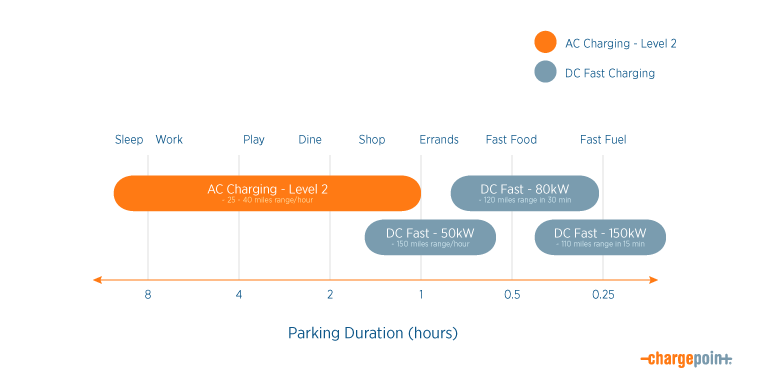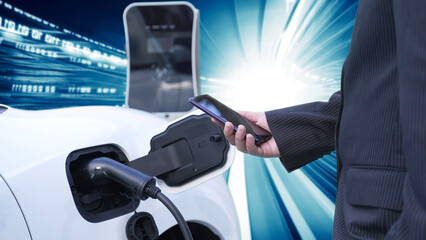EV Charging: What’s Broken and How Tesla Has the Fix
As electric vehicles become more popular, having a reliable and ubiquitous charging infrastructure becomes increasingly important. But it’s not only the infrastructure that needs to function and be omnipresent: the key to successful transportation electrification also lies in a superior customer experience.
The transition from a pay-at-the-pump transactional refueling experience to one based on having a relationship with the Charge Point Operator (CPO) will be a major shift in the customer experience over the next decade. To ensure the EV industry continues to grow, this transition must incorporate various technologies to provide the availability, reliability, and simplicity customers will expect.
Tesla electric vehicles. Image used courtesy of Adobe Stock
EV Charging Stations Are Broken, Literally
According to a study of public EV charging stations based in California's Bay Area, only 72.5% were operational. The study out of the University of California Berkeley, Cool the Earth, a nonprofit focused on reducing carbon emissions, and retired professor of bioengineering David Rempel revealed that California's charging infrastructure has significant reliability issues. This is particularly concerning given that California has the highest number of EV owners in the United States and has long been a leader in developing electric and hybrid vehicles.
The reasons for the chargers’ downtime were manifold: from network connectivity problems, broken plugs, and unresponsive screens to payment system failures. Additionally, approximately 5% of connectors had cables that weren’t capable of reaching the EV charging port, making them unusable. This study is just one piece of a growing body of evidence indicating that EV charging needs to become more convenient for there to be widespread adoption of battery-powered vehicles.
In 2021, 60% of all EV charging stations in the U.S. were Tesla Superchargers, but China still had 85% of the world’s fast charger stations.
Tesla was one of the first to enter the EV market–allowing it to establish a strong brand and customer base and gain an advantage over other manufacturers. Additionally, Tesla has invested heavily in research and development. This has resulted in the development of advanced EV technology, such as its high-performance electric motors and battery systems.
Cars being charged at a Tesla charging station. Image used courtesy of Adobe Stock
One of the key reasons why Tesla has an advantage is that it operates its own network of charging stations, allowing it to provide convenient and reliable charging options for its customers. This is in contrast to other car manufacturers, which often rely on third-party charging networks, where compatibility, or rather the lack thereof, plays a key role.
The incumbent large car manufacturers might be well-advised to invest in building up their own charging network vs. relying on third parties. That’s if they want to be at the forefront of an electrified transportation future.
Standards for a Seamless Charging Experience
For a third-party charging experience to function well, the charging station hardware (EVSE, or Electric Vehicle Supply Equipment), the cellular networks that give the stations internet connectivity, and charging station management software (CSMS) must interact with each other and the EV driver.
To understand the interplay between these technologies, let’s have a look at what EV drivers typically do when they need to charge their car:
-
Make a reservation for a particular charger before arriving at the charging station, typically through a mobile app or through messaging.
-
On the backend, this charger is put on hold for the driver.
-
As the driver arrives, they identify themselves, and the charger authorizes them.
-
The charger physically unlocks the connector the driver plugs into their car.
-
The charger starts the charging session.
-
The driver enters a nearby store for a cup of coffee and eventually receives a notification that the charging session has ended.
-
The driver sets the connector back into the socket, and the charger locks the socket.
-
The charger triggers a billing event with the driver according to their usage and the CPO’s pricing.
For this sequence of events to run like a well-oiled machine, the EVSE manufacturers, connectivity providers, and software vendors that all play a role behind the scenes must agree on a way for their technologies to work together.
A man waits while his EV is charged. Image used courtesy of Adobe Stock
Luckily, a protocol exists to standardize how these players talk to each other. The Open Charge Point Protocol (OCPP) is the open-source language used by charging stations and network management systems to communicate with one another, no matter how different they may be.
The OCPP’s role is to make any EV charging station work compatibly with any charger management software.
Charge points that rely on OCPP compliance to enable charging sessions, manage remote diagnostics, and ensure a secure data exchange will have an advantage in this increasingly competitive space.
Factors Affecting EV Charging
EV charging involves a more complex experience than simply stopping at a nearby station and filling up for a few minutes before paying at the pump.
These factors all come into play:
-
Charger type (fast/slow, connector type)
-
Participation in a subscriber network
-
The presence of mobile apps
-
The right payment options
-
Nearby amenities
As a result, the customer experience is crucial for operators in the public charging market, and those who provide the best experience are likely to be the most successful.
For an enjoyable charging experience, chargers need to be found in attractive locations, which today they often aren’t. Why is that?
First, we need to understand the correlation between charging speed and the type of amenities that should be available nearby. As retailers, shopping mall owners, and other types of businesses start to choose the right type of charger for their parking lots, it's important to consider how long customers are likely to be parked at their locations.
Providing Level 2 AC charging access, which adds 25 to 40 miles of range per hour, means customers could be parked for an hour or more (as much as eight to 10 hours) at retail locations, restaurants, and workplaces, as well as residences and hospitality locations.
On the other hand, DC fast chargers can add 150 miles of range per hour or more, making them a good fit for locations where drivers will be parked for less than an hour, including fuel retailers, convenience stores, fast food restaurants, and other retail locations.
Parking duration is shown for AC charging and DC fast charging. Image used courtesy of ChargePoint
By aligning the charging speed with their business model, these retailers and other real estate owners can provide a great experience for drivers and generate more revenue for their businesses.
App Fatigue
Phone calls are no longer the main way of interacting with businesses. But even the mobile app is no longer the end-all-be-all of customer engagement. App fatigue is a growing problem for many and can negatively impact EV drivers’ overall charging experience.
App fatigue refers to the feelings of frustration and overload that occur when a person has to use multiple apps to accomplish a single task. In the case of EV charging, this is a bitter reality today as drivers use different apps to locate and access charging stations, pay for charging sessions, and track their energy usage.
The proliferation of different charging networks and payment systems has, indeed, contributed to app fatigue among EV drivers. To find and use the most convenient charging station, drivers often have to download and use multiple apps, each with its own user interface and set of features. This can be frustrating and time-consuming and lead to confusion and errors–or, worst case, outright rejection.
An entirely different approach would be to no longer rely on apps as a must-have for using a single charger or a network of stations. Companies like Twilio have shown the world how messaging channels like SMS, WhatsApp, and Facebook Messenger can become the main channel for B2C customer engagement, as we are all now texting with our Uber drivers or even getting customer service over SMS.
Thanks to the ubiquity and robustness of these channels and their underlying enabling technologies, customers can now interact securely with businesses without having to download an app first. Through a smart combination of messaging and mobile web pages, as well as trusted account activation techniques like Silent Network Authentication that build truly effortless onboarding and transaction experiences, customers can create accounts without dealing with passwords, access chargers, and conduct payments all through the exchange of a few messages.
Communicating Charger Data to Customers
Finally, CPOs must determine how to tie charger data directly into the communication with EV drivers, as this can further help improve the customer experience in several ways.
First, it can provide drivers with real-time information about the availability and status of charging stations. This can help drivers avoid charging stations that are out of service or unavailable and can provide information on how long they will need to wait for a charging station to become available.
Information about nearby EV charging stations is available via phone. Image used courtesy of Adobe Stock
Second, tying charger data directly into the communication with EV drivers can allow charging networks and payment systems to provide personalized and relevant information to drivers. For example, if a driver is running low on battery and needs to find a charging station quickly, the charging network could provide them with information about nearby charging stations available with fast charging speeds.
But not only that–operators can also start sending promotional messages, such as discounts at a nearby store, as long as they can tap into the charger data and into knowledge about the customer’s communication preferences. A relatively new breed of enterprise software–customer data platforms–makes this possible.
Overall, tying charger data directly into communication with EV drivers can improve the customer experience by providing real-time information, personalized recommendations, and a more integrated experience. This can help to make EV charging more convenient and enjoyable, accelerating the adoption of electric vehicles.
Key Takeaways of the EV Charging Experience
We have identified five key issues that stand in the way of a smooth and enjoyable customer experience: unreliable chargers, incompatible technologies, poor choice of charger locations, app fatigue, and integrating charger data directly into the customer experience. Those charge point operators who not only understand the challenges that lie ahead but are also willing to meet those challenges head-on and embrace modern technologies will survive in the increasingly competitive space of providing EV charging solutions.











